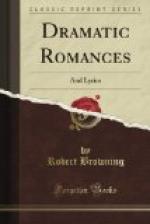The counter our lovers staked was lost
As surely as if it were lawful coin:
And the sin I impute to each frustrate ghost
Is—the unlit lamp and the ungirt loin,
Though the end in sight was a vice, I say.
You of the virtue (we issue join)
How strive you? De te, fabula!
250
Notes: “The Statue and the Bust” creates the characters and the situation, and dramatically represents a story which is based on a Florentine tradition that Duke Ferdinand I placed his equestrian statue in the Piazza dell’ Annunziata so that he might gaze forever towards the old Riccardi Palace, where a lady he loved was imprisoned by her jealous husband. The bride and her ducal lover are seen exchanging their first looks, through which they perceive the genuineness of their love; and the temporizing of each is presented, through which, for the sake of petty conveniences, they submit to be thwarted by the wary husband, and to have the end they count supreme delayed until love and youth have gone, and the best left them is the artificial gaze interchanged by a bronze statue in the square and a clay face at the window. The closing stanzas point the moral against the palsy of the will, whose strenuous exercise is life’s main gift.
I. There’s a palace in Florence: refers to the old Riccardi Palace, now the Palazzo Antinori, in the square of the Annunziata, where the statue still stands.
22. encolure: neck and shoulder of a horse
33. The pile which the mighty shadow makes: refers to another palace in the Via Larga where the duke (not the lady) lived, and which is to-day known as the Riccardi Palace. Cooke’s “Browning Guide Book” and Berdoe’s “Browning Cyclopaedia” both confuse the two, attributing error to Browning in spite of his letter about it. This confusion was cleared up by Harriet Ford (Poet-lore, Dec. 1891, vol. iii. p. 648, “Browning right about the Riccardi Palace’’).
36. Because of a crime, etc.: refers to the destroying of the liberties of the Florentine republic by Cosimo dei Medici and his grandson, Lorenzo, who lived in the then Medici (now Riccardi) Palace, whose darkening of the street with its bulk symbolizes the crime which took the light from Florence.
57. catafalk: the stage or scaffolding for a coffin whilst in the church
94. Arno bowers: the palace by the Arno, the river flowing through Florence.
95. Petraja: a Florentine suburb.
169. Robbia’s craft: the Robbia family were skilled in shaping the bisque known as Della Robbia ware which was long one of the Florentine manufactures, and traces of which, when Browning wrote, still adorned the outer cornice of the palace.
202. John of Douay [Giovanni of Bologna], sculptor (1524-1608). The statue is one of his finest works.
250.. De te, fabula! Concerning thee, this fable!




